PRINCETON, NJ -- A ���۴�ýpoll finds 61% of Americans viewing the military power of Iran as a critical threat to U.S. vital interests over the next 10 years. An additional 29% say Iran is an important, though not a critical, threat to the United States. The findings come as Secretary of State Hillary Clinton is seeking the support of several Arab nations for additional sanctions on Iran in a trip to the region this week.
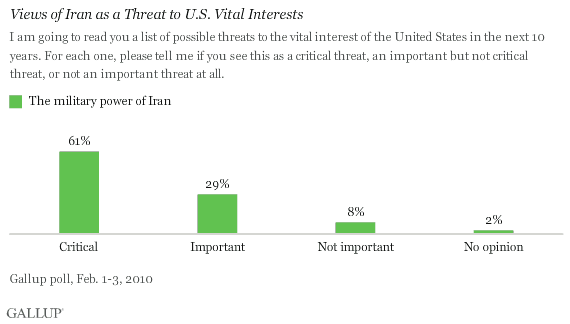
"There is a notable difference in perceptions of Iran by age. Younger Americans (those aged 18 through 29) are significantly less likely than Americans aged 30 and older to view Iran as a critical threat."
The findings are based on a Feb. 1-3 ���۴�ýpoll that asked Americans to assess the threat of each of seven international issues to the United States. Only international terrorism was more likely to be rated as a critical threat to U.S. vital interests than Iran. Americans rated the military power of North Korea and Iran as equal threats.
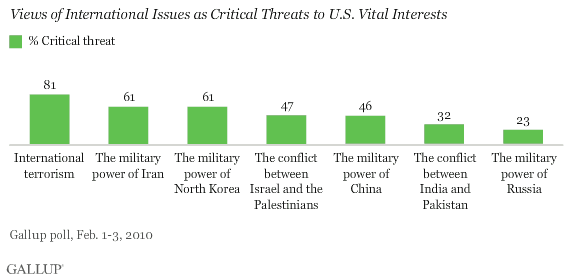
The poll was conducted prior to Clinton's trip, and it is unclear whether her remarks have changed Americans' views on how serious a threat Iran is to the United States. Clinton warned that Iran is moving toward a military dictatorship as the United States and other nations seek to prevent it from developing nuclear weapons.
A majority of Republicans, independents, and Democrats view Iran's military power as a critical threat to the U.S., though Republicans are somewhat more likely to do so (at 68%, compared to 60% for independents and 57% for Democrats).
There is a notable difference in perceptions of Iran by age. Younger Americans (those aged 18 through 29) are significantly less likely than Americans aged 30 and older to view Iran as a critical threat.
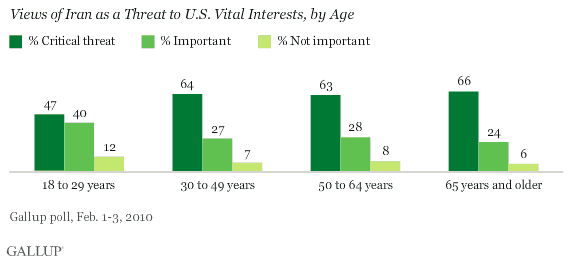
Older Americans are more likely than younger Americans to perceive that several of the issues tested are critical threats to the United States. However, the greatest difference by age is on Iran, and could stem in part from the fact that young adults were not yet born when U.S.-Iran tensions were arguably at their greatest, during the 1979-1981 Iranian hostage crisis.
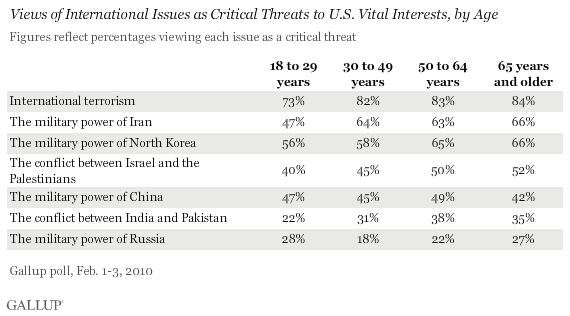
Partisan differences in evaluations of the seven international issues as threats are generally small. Though Republicans are more likely than Democrats to perceive six of the seven issues as critical threats, Republican-Democratic differences are only as large as 12 percentage points on terrorism and 11 points on the military power of Iran.
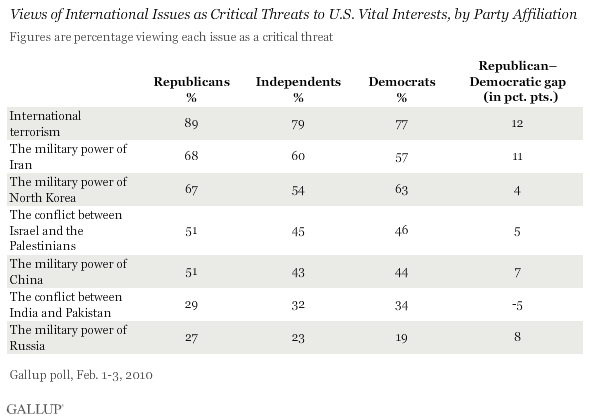
There is a larger difference by political ideology with respect to China's military power, which 55% of conservatives regard as a critical threat, compared with 35% of liberals. Like Republicans, conservatives tend to view the various issues as more serious threats.
Changes in Views of Issues as Threats
Terrorism also ranked as the top issue . Americans' perceptions of the threat of international terrorism are essentially the same today as six years ago. In 2004, 82% said terrorism was a critical threat to U.S. interests, compared with the 81% in the latest poll.
Similarly, there has been essentially no change in the perceived threat of the India-Pakistan conflict. However, since 2004, Americans have become more likely to view the military power of China as a critical threat (39% in 2004 vs. 46% today) and the military power of Russia as a threat (18% vs. 23%).
The biggest change has been with respect to the conflict in the Middle East. The percentage of Americans believing the Israeli-Palestinian conflict is a critical threat to the U.S. has fallen from 58% to 47%.

Bottom Line
It's not clear whether the United States will succeed in getting the international community to impose additional sanctions on Iran. Nine in 10 Americans view Iran as an important threat to U.S. vital interests, including 61% who say it is a critical threat. That puts concern about Iran on par with North Korea, another nation with nuclear ambitions, and behind only international terrorism.
Survey Methods
Results are based on telephone interviews with 1,025 national adults, aged 18 and older, conducted Feb. 1-3, 2010. For results based on the total sample of national adults, one can say with 95% confidence that the maximum margin of sampling error is ±4 percentage points.
Interviews are conducted with respondents on land-line telephones (for respondents with a land-line telephone) and cellular phones (for respondents who are cell-phone only).
In addition to sampling error, question wording and practical difficulties in conducting surveys can introduce error or bias into the findings of public opinion polls.
